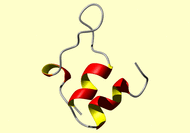
NMR Restraints Grid

 |
NMR Restraints Grid |
 |
Result table
| image | mrblock_id | pdb_id | bmrb_id | cing | stage | program | type |
|
|
2010 |
1bbl |
2546 | cing | 1-original | MR format | comment |
*HEADER GLYCOLYSIS 20-FEB-92 1BBL *COMPND E3-BINDING DOMAIN OF THE DIHYDROLIPOAMIDE *COMPND 2 SUCCINYLTRANSFERASE (E.C.2.3.1.61) CORE FROM THE *COMPND 3 2-OXOGLUTARATE DEHYDROGENASE MULTIENZYME COMPLEX OF *COMPND 4 (ESCHERICHIA $COLI) (/NMR$, MINIMIZED AVERAGE STRUCTURE) *SOURCE SYNTHETIC PEPTIDE COMPRISING THE E3-BINDING DOMAIN OF THE *SOURCE 2 DIHYDROLIPOAMIDE SUCCINYLTRANSFERASE CORE FROM THE *SOURCE 3 2-OXOGLUTARATE DEHYDROGENASE MULTIENZYME COMPLEX OF *SOURCE 4 (ESCHERICHIA $COLI) *REVDAT 1 15-JUL-93 1BBL 0 REMARK Experimental restraints used in the 3D NMR solution structure REMARK determination of the E3-binding domain REMARK of the dihydrolipoamide succinyltransferase core from the REMARK 2-oxoglutarate dehydrogenase multienzyme complex of E. coli REMARK REMARK Authors: G.M. Clore, Mark A. Robien and A.M. Gronenborn REMARK REMARK References REMARK REMARK 1. Robien, M.A., Clore, G.M., Omichinski, J.G., Perham, R.N. REMARK Appella, E., Sakaguchi, K. and Gronenborn, A.M. (1992) REMARK Three-dimensional solution structure of the E3-binding domain REMARK of the dihydrolipoamide succinyltransferase core from the REMARK 2-oxoglutarate dehydrogenase multienzyme complex of E. coli REMARK Biochemistry in press REMARK REMARK REMARK Details of the structure determination and all structural REMARK statistics are given in ref. 1 (i.e. agreement with experimental REMARK restraints, deviations from ideality for bond lengths, angles, REMARK planes and chirality, non-bonded contacts, atomic rms differences REMARK between the calculated structures). REMARK The structures are based on 630 interproton distance restraints REMARK derived from NOE measurements; and 46 phi and 35 psi backbone REMARK torsion angle restraints and 20 chi1 side chain torsion angle REMARK restraints derived from coupling constants and NOE data. The REMARK latter are obtained using REMARK the conformational grid search program STEREOSEARCH [Nilges, M., REMARK Clore, G.M. & Gronenborn, A.M. (1990) Biopolymers 29, 813-822 REMARK The method used to determine the structures REMARK is the hybrid metric matrix distance geometry-dynamical simulated REMARK annealing method [Nilges, M., Clore, G.M. & Gronenborn, A.M. REMARK FEBS Lett. 229, 317-324 (1988)]. REMARK REMARK REMARK A total of 56 structures were calculated. The coordinates REMARK are given in e2o_brookhaven.pdb REMARK REMARK REMARK NOE approximate interproton distance restraints are listed in (A) REMARK and torsion angle restraints in (B). REMARK A. NOE interproton distance restraints The restraints are represented by square-well potentials with the upper (u) and lower (l) limits given by u=i+k and l=i-j where the numbers are entered in the order i,j,k. [Clore et al. (1986) EMBO J. 5, 2729-2735] The NOEs are classified into three distance ranges corresponding to strong, medium and weak NOEs. These are 1.8-2.7 A, 1.8-3.3 A and 1.8-5.0 A, respectively. Appropriate corrections to the upper limits for distances involving methyl, methylene and Tyr and Phe aromatic ring protons, to account for centre averaging, are carried out as described by Wuthrich et al. [J. Mol. Biol. 169, 949-961 (1983)]. In addition, an extra 0.5 A is added to the upper limits of distances involving methyl protons [Clore et al. (1983) Biochemistry 26, 8012-8023; Wagner et al. (1987) J. Mol. Biol. 196, 611-640]. The atom notation follows standard PDB format. The # indicates a single wild card, and the * a full wild card. e.g. For Leu, HD* representes all the methyl protons; for a normal methylene beta proton, HB# represents the two protons. In these cases, the distances are calculated as centreaverages. Note that the hard sphere van der Waals repulsion term ensures that the minimum lower limit for all distances is the sum of the relevant hard sphere atom radii. (i) Intraresidue restraints
Contact the webmaster for help, if required. Wednesday, May 1, 2024 11:29:27 PM GMT (wattos1)